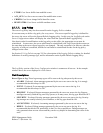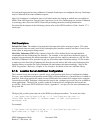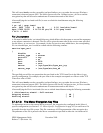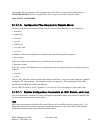
and usage. The trade-off for this value is that large buffer sizes will use more system memory and may be
inefficient for small transfers (e.g., if the Mover buffer size is 4MB, but client requests are 512KB, the
Mover will not achieve any double buffering benefit because the entire amount of the transfer fits in one
Mover buffer). A smaller buffer size will cause device and network I/O to be interrupted more often,
usually resulting in reduced throughput rates for all but the smallest transfers.
The minimum Mover buffer size is the size of smallest block size for any device the Mover will handle.
The maximum value will be bounded by the available system memory and the number of concurrent
Mover requests anticipated.
TCP Path Name. The pathname of the Mover TCP/IP listen executable. The default value is “/opt/hpss/
bin/hpss_mvr_tcp”. The TCP Movers currently supported are listed below. All TCP Movers support
common disk/tape interfaces, TCP/IP, and shared memory data transfers.
The hpss_mvr_ssd executable provides support for the IBM SCSI Tape Device Driver.
Table 4. Mover TCP Pathname Options
Name Options Supported
hpss_mvr_tcp Standard disk/tape devices – tape devices that use the Native SCSI device driver
hpss_mvr_ssd Disk and SCSI 3590/3590E/3590H/3580, as well as tape device that uses IBM
Atape device driver
hpss_mvr_dd2 Disk and Ampex DST-312 – tape devices that use the DD2 device driver
Hostname. The name of the host interface used for Mover control communication. This must be a valid
host name for one of the network interfaces on the Mover node. The Execute Hostname of the Core
Server Configuration window is used as the default. If the Mover is running remotely, this field must
correspond to a network interface on the remote node, whereas the Execute Hostname set in the
Mover’s basic configuration corresponds to a network interface on which the administrative portion of
the Mover runs.
Data Hostname. The host network interface name to be used by the Mover when transferring data. This
must be a valid host name for one of the network interfaces on the Mover node. The default value is the
Execute Hosname of the Core Server Configuration window. This field must correspond to a network
interface on the remote node.
TCP Port. The TCP/IP port number used by the administrative interface portion of the Mover for the
TCP/IP listen process to receive connections. It should be a value over 5000. The default value is 5001.
The port number must be unique for processes running on the same node.
The Mover will internally use the port one greater than the one configured in this field on the remote
node during initialization (e.g., if 5001 is entered, port 5002 is used on the remote node); therefore
available port ranges on both nodes must be taken into consideration when selecting this value.
Port Range Start. The beginning of a range of local TCP/IP port numbers to be used by the Mover when
connecting to clients. Valid values are zero or any valid TCP port number to which the Mover may bind
(that is less than or equal to the value of Port Range End). The default value is 0. Use of particular port
ranges may be required by some sites for communication across a firewall. If this value is set to zero, the
operating system will select the port number; otherwise the Mover selects a local port number between
Port Range Start and Port Range End (inclusive). If non-zero, this field must be less than or equal to Port
HPSS Management Guide November 2009
Release 7.3 (Revision 1.0) 103


















